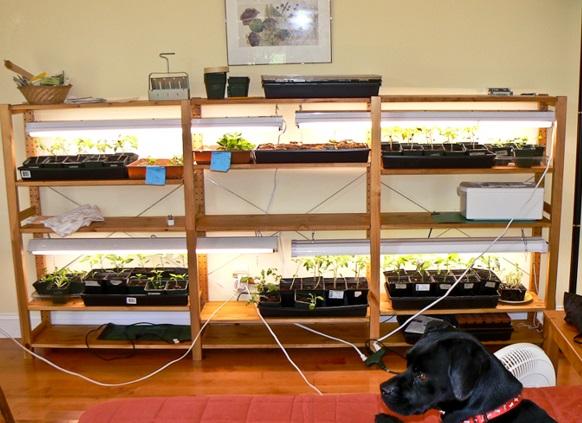The natural light from a window is seldom enough for good, strong seedling growth. They will usually stretch and lean towards the light and will not produce sturdy plants. Sowing seeds indoors under fluorescent lights is the easiest way for the home gardener to control growing conditions and grow healthy transplants. Incandescent bulbs give off more heat and less light (mostly red) than fluorescent tubes and will not produce good transplants by themselves.
- Many gardeners use inexpensive and widely available “shop lights”-- 4-ft. long lightweight metal fluorescent fixtures that take two T-8 fluorescent tubes (multiply the T-number X 1/8 inches to get tube diameter; in this case 8/8 or 1 inch). T-8 fixtures and tubes have largely replaced and are more energy-efficient than T-12 fixtures and tubes.
- You can hang these fixtures by removing the strip or panel above the tubes and inserting the chain or wire through the hole(s) in the top of the fixture.
- T-5 fluorescent fixtures and tubes are another option. They are relatively expensive but typically allow for more rapid and robust plant growth. Unlike T-8 tubes, the T-5 tubes can’t be used in a T-12 fixture (common shop light).
Light stands
- Chlorophyll absorbs most of its energy from the violet-blue and orange-red wavelengths.
- Cool, white tubes (40 watts) produce light in the blue and yellow-green segments of the light spectrum. They are the least expensive and the mostly blue light can produce healthy, stocky salad greens and vegetable transplants.
- The more expensive full-spectrum fluorescent tubes (“grow lights”) produce a balance of warm (red) and cool (blue) light. “Grow lights” enhance foliar growth and produce thicker stems than cool white tubes, and are needed for producing flowers on indoor plants.
- Some gardeners insert one warm and one cool tube into a fixture to gain the same effect.
- Refer to Do-it-Yourself PVC table-top light stand (photos and step-by-step instructions) and starting seeds indoors.
| Type | Diameter of tubes | Light output (initial lumens* per tube) |
Tube Life (hrs.)** | Notes |
|---|---|---|---|---|
| T-12 (40w) | 1 1/2 inches | 1500 - 3200 | 10,000 -20,000 | No longer the industry standard |
| T-8(32w) | 1 inch | 2800 | 30,000 -40,000 | 20-25% more efficient than T-12 |
| T-5 (54w) | 5/8 inch | 5000 | 30,000 | 9% more efficient than T-8 |
| T-12 (Wide Spectrum) | 1 1/2 inches | 1700 | 20,000 | Type of “Gro-Light” (adds red and far-red to blue light) |
*Lumens measures light intensity over the visual spectrum- the brightness that we see.
** Over time the bulbs begin to lose their intensity. T-8 bulbs have a slower period of decrease, losing about 10% of initial brightness after 7,000 hours. T-12 bulbs can lose 20% after the same number of hours.
